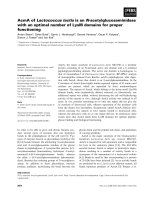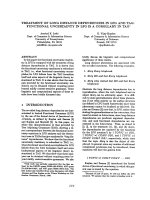Báo cáo khoa học: "Treatment of atelectasis: where is the evidence" pdf
Bạn đang xem bản rút gọn của tài liệu. Xem và tải ngay bản đầy đủ của tài liệu tại đây (32.42 KB, 2 trang )
341
DNase = deoxyribonuclease.
Available online />Abstract
Lobar atelectasis is a common problem caused by a variety of
mechanisms including resorption atelectasis due to airway
obstruction, passive atelectasis from hypoventilation, compressive
atelectsis from abdominal distension and adhesive atelectasis due
to increased surface tension. However, evidence-based studies on
the management of lobar atelectasis are lacking. Examination of air-
bronchograms on a chest radiograph may be helpful to determine
whether proximal or distal airway obstruction is involved. Chest
physiotherapy, nebulised DNase and possibly fibreoptic broncho-
scopy might be helpful in patients with mucous plugging of the
airways. In passive and adhesive atelectasis, positive end-
expiratory pressure might be a useful adjunct to treatment.
In this issue of Critical Care, Hendriks and colleagues [1]
report on the use of nebulised or endotracheal DNase in
paediatric patients with atelectasis. Pulmonary atelectasis is
one of the most common abnormalities encountered on chest
radiography and is caused by a variety of processes. These
include: resorption atelectasis caused by resorption of
alveolar air distal to obstructing lesions of the airways;
adhesive atelectasis from increased surface tension and
surfactant deficiency after ventilator-associated pneumonia;
passive atelectasis caused by diaphragmatic dysfunction, or
hypoventilation; compressive atelectasis due to space-
occupying intrathoracic lesions or abdominal distension; and
cicatrisation atelectasis due to pulmonary fibrosis [2]. Thus,
when evaluating a patient with atelectasis, it is important to
understand the mechanism, cause and functional significance
of the atelectasis in that patient before possible treatment
strategies can be developed, because no single therapy is
likely to be successful in all forms of atelectasis.
On review of the literature it becomes apparent that there is a
complete lack of evidence-based studies to guide the
management of this common problem. Treatment modalities
that have been described include chest physiotherapy [3],
bronchodilators [3], fibreoptic bronchoscopy [4], DNase [1],
positive end-expiratory pressure [5] and surfactant [6].
Chest physiotherapy is the traditional first-line therapy for
atelectasis [4]; however, even for this basic therapy, evidence
is lacking: there are only two published studies [7,8]. In 57
ventilated children, chest physiotherapy with saline lavage
and simulated cough was successful in improving lung
expansion in 84% of patients [7]. If physiotherapy fails, further
examination of the chest radiograph to identify the level of air
bronchogram may be helpful to identify whether airway
obstruction is the cause and to determine whether proximal
lobar or distal bronchi are involved [4]. Fibreoptic broncho-
scopy to aspirate secretions has been used in the manage-
ment of proximal airway obstruction, and has been found to
resolve atelectasis successfully in 26 of 35 (74%) paediatric
intensive care patients [9]. However. in a small randomised
control trial, fibreoptic bronchoscopy did not improve the rate
of resolution of volume loss in comparison with chest
physiotherapy, and it may have adverse effects on intracranial
pressure [8]. Nebulised bronchodilators are traditionally
recommended for the management of atelectasis [3]. In
patients with acute bronchoconstriction, a bronchodilator
may increase airway diameter and hence improve secretion
clearance, but there are no published studies evaluating its
use in the management of atelectasis in asthmatic or non-
asthmatic patients. In infants and children with bronchiolitis,
nebulised adrenaline (epinephrine) to decrease airway
mucosal oedema and hence increase airway diameter may be
more beneficial than bronchodilators [10].
Nebulised or direct tracheal application of DNase reduces
the viscoelastic properties of purulent airway secretions by
breaking down the highly polymerised deoxyribonucleic acid
[1]. Reducing the viscosity of the secretions makes them
easier to clear, and DNase may thus reduce mucous plugging
of airways and hence improve atelectasis. Again, there are no
Commentary
Treatment of atelectasis: where is the evidence?
Margrid B Schindler
Consultant in Paediatric Intensive Care, Paediatric Intensive Care Unit, Bristol Royal Hospital for Children, Bristol, UK
Corresponding author: Margrid B Schindler,
Published online: 7 July 2005 Critical Care 2005, 9:341-342 (DOI 10.1186/cc3766)
This article is online at />© 2005 BioMed Central Ltd
See related research by Hendriks et al. in this issue [ />342
Critical Care August 2005 Vol 9 No 4 Schindler
randomised control trials evaluating its use in the management
of atelectasis, but there is one randomised trial of 75 infants
with respiratory syncytial virus bronchiolitis, showing an
improvement in chest radiograph scores in the patients given
nebulised DNase [11]. For the management of atelectasis,
there are five small published case series describing the
successful use of DNase in one to five patients [1].
Hendriks and colleagues [1] now describe the use of DNase
in the largest retrospective case series published so far,
involving 25 children with persistent atelectasis despite
physiotherapy and bronchodilators. In this study, 68% of
patients improved after DNase administration. The lack of
improvement in all the patients might have been partly due to
the diverse aetiologies and predisposing factors present
which included airway malacia, psychomotor retardation,
neuromuscular disease, cardiovascular disease, bronchiec-
tasis, and chronic lung disease. DNase is more likely to
improve atelectasis due to mucous plugging of the airways,
and some of these patients would have had other
mechanisms of atelectasis such as passive and adhesive-
induced atelectasis. Also of note is the observation that direct
tracheal administration of DNase resulted in deterioration in
three patients due to presumed rapid mucous mobilisation as
a result of the higher delivered dose. This did not occur after
nebulised administration of the DNase, which suggests that if
direct tracheal administration is used, a small dose should be
tried initially.
For atelectasis not due to mucous plugging of the airways,
increased end-expiratory pressure has been used and resulted
in complete resolution of lobar atelectasis in four patients [5]
and re-expansion of atelectasis in experimental studies [12].
Atelectasis in 12 ventilated adults was associated with
increased total protein, inflammatory markers and reduced
surfactant in the bronchoalveolar lavage fluid, suggesting
increased alveolar-capillary permeability, severe surfactant
abnormalities, and signs of local inflammatory reaction [13].
This suggests a possible role for surfactant, and it has been
used successfully to re-expand left lobar atelectasis in an adult
with asthma [6]. It is curious that surfactant has not been used
more extensively in the management of atelectasis; however,
the traditional volumes used (4 ml/kg) are large, resulting in
increased expense. Small volumes may be equally effective:
0.5 ml/kg fluorocarbon facilitates lung recruitment by reducing
surface tension and ungluing adherent lung surfaces in saline-
lavaged rabbits [14].
Overall, however, it is clear that there are very few published
studies available to guide our management of lobar atelectasis,
which is a common complication in critically ill patients; further
studies are urgently needed. Hendriks and colleagues [1] are
to be commended in attempting to fill this void.
Competing interests
The author(s) declare that they have no competing interests.
References
1. Hendriks T, de Hoog M, Lequin MH, Devos AS, Merkus P: DNase
and atelectasis in non-cystic fibrosis pediatric patients. Criti-
cal Care 2005, 9:R351-R356.
2. Woodring JH, Reed JC: Types and mechanisms of pulmonary
atelectasis. J Thoracic Imaging 1996, 11:92-108.
3. Peroni DG, Boner AL: Atelectasis: mechanisms, diagnosis and
management. Paediatr Respir Rev 2000, 1:274-278.
4. Harris RS: The importance of proximal and distal air bron-
chograms in the management of atelectasis. J Can Assoc
Radiol 1985, 36:103-109.
5. Fowler AA, Scoggins WG, O’Donohue WR: Positive end-expira-
tory pressure in the management of lobar atelectasis. Chest
1978, 74:497-500.
6. Westhoff M, Freitag L: Surfactant treatment of complete lobar
atelectasis after exacerbation of bronchial asthma by infec-
tion. Pneumologie 2001, 55:130-134.
7. Galvis AG, Reyes G, Nelson WB: Bedside management of lung
collapse in children on mechanical ventilation: saline lavage-
simulated cough technique proves simple, effective. Pediatr
Pulmonol 1994, 17:326-330.
8. Marini JJ, Pierson DJ, Hudson LD: Acute lobar atelectasis: a
prospective comparison of fiberoptic bronchoscopy and res-
piratory therapy. Am Rev Respir Dis 1979, 119:971-978.
9. Bar-Zohar D, Sivan Y: The yield of flexible fiberoptic broncho-
scopy in pediatric intensive care patients. Chest 2004, 126:
1353-1359.
10. Schindler M: Do bronchodilators have an effect on bronchioli-
tis? Critical Care 2002, 6:111-112.
11. Nasr SZ, Strouse PJ, Soskolne E, Maxvold NJ, Garver KA, Rubin
BK, Moler FW: Efficacy of recombinant human deoxyribonu-
clease I in the hospital management of respiratory syncytial
virus bronchiolitis. Chest 2001, 120:203-208.
12. Luecke T, Roth H, Herrmann P, Joachim A, Weisser G, Pelosi P,
Quintel M: PEEP decreases atelectasis and extravascular lung
water but not lung tissue volume in surfactant-washout lung
injury. Intensive Care Med 2003, 29:2026-2033.
13. Nakos G, Tsangaris H, Liokatis S, Kitsiouli E, Lekka ME: Ventila-
tor-associated pneumonia and atelectasis: evaluation through
bronchoalveolar lavage fluid analysis. Intensive Care Med
2003, 29:555-563.
14. Cox PN, Frndova H, Karlsson O, Holowka S, Bryan CA: Fluoro-
carbons facilitate lung recruitment. Intensive Care Med 2003,
29:2297-2302.









